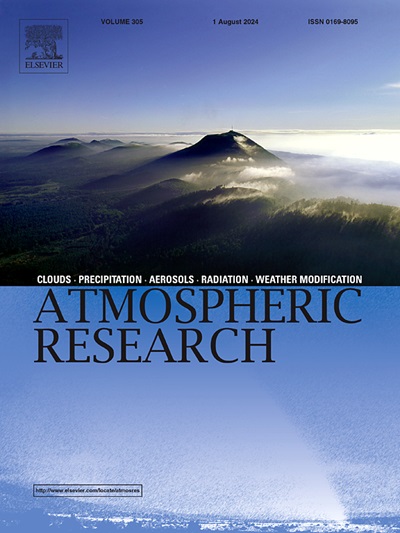Intercomparison of GPM hourly precipitation products: Assessing the strengths in capturing precipitation events and their properties
IF 4.5
2区 地球科学
Q1 METEOROLOGY & ATMOSPHERIC SCIENCES
引用次数: 0
Abstract
Spatially and temporally enhanced satellite precipitation products (SPPs) from the GPM mission offer a viable alternative to ground-based measurements. Although the SPPs have been extensively evaluated at specific time scales, such as hourly and daily, the temporally continuity feature of precipitation events is often overlooked. This study assessed and intercompared the performance of six GPM hourly SSPs, i.e. Early, Late and Final from IMERG, and NRT, MVK, NRT_GC (hereafter GC) from GSMaP, focusing on capturing three key precipitation properties (i.e. depth, duration and intensity) along with peak magnitude and timing, in order to obtain a comprehensive understanding of their capability and potential for precipitation monitoring and related hydrometeorological applications. The minimum inter-event time (MIT) approach, with a range of threshold values (i.e. 1, 2, 6, 10 and 24 h), was adopted to delineate precipitation events for the SSPs and the reference data (site observations and CLDAS datasets). IMERG and GSMaP products revealed their respective strengths in detection capacity of precipitation events, with IMERG achieving lower FAR and GSMaP showing higher POD. Despite comparable capabilities in estimating the depth of precipitation events by all the SPPs, IMERG products tended to be more effective in characterizing precipitation intensity and event peak while GSMaP better identified event duration. Notably, near/post real-time products outperformed gauge-corrected versions in certain aspects. Early was more capable of capturing event-based precipitation properties compared to the other IMERG products, especially for shorter MITs, suggesting the potential of near-real-time products in precipitation monitoring and early warning of associated hazards. In addition, MVK excelled in characterizing event duration, intensity, and peak magnitude within the GSMaP system, revealing the possible effectiveness of gauge-free satellite retrieval algorithms. Subregion analysis using the K-means clustering algorithm demonstrated the integrated influence of multiple factors on the performance of the SPPs, also with region-dependent sensitivity to a specific factor. The findings obtained from this study could provide new insights into the practical application and possible further enhancement of the GPM SPPs.
GPM逐时降水产品的相互比较:评估捕获降水事件及其性质的优势
来自GPM任务的空间和时间增强卫星降水产品(SPPs)为地面测量提供了一个可行的替代方案。虽然spp已经在特定的时间尺度上进行了广泛的评估,如每小时和每天,但降水事件的时间连续性特征往往被忽视。通过对IMERG的Early、Late、Final和GSMaP的NRT、MVK、NRT_GC(以下简称GC) 6个GPM逐时ssp的性能进行评价和比较,重点捕捉降水深度、持续时间和强度3个关键特征以及峰值大小和时间,全面了解它们在降水监测和水文气象应用方面的能力和潜力。最小事件间时间(MIT)方法采用一系列阈值(即1、2、6、10和24 h)来描述ssp和参考数据(现场观测和CLDAS数据集)的降水事件。IMERG和GSMaP产品在降水事件探测能力上显示出各自的优势,IMERG的FAR较低,GSMaP的POD较高。尽管所有spp在估计降水事件深度方面的能力相当,但IMERG产品在表征降水强度和事件峰值方面往往更有效,而GSMaP产品更好地识别事件持续时间。值得注意的是,近实时/后实时产品在某些方面优于量规校正版本。与其他IMERG产品相比,Early更有能力捕捉基于事件的降水特性,特别是对于较短的MITs,这表明了近实时产品在降水监测和相关危害早期预警方面的潜力。此外,MVK在表征GSMaP系统内的事件持续时间、强度和峰值量级方面表现出色,揭示了无规卫星检索算法的可能有效性。使用K-means聚类算法的子区域分析显示了多个因素对SPPs性能的综合影响,并且对特定因素具有区域依赖的敏感性。本研究结果可以为GPM SPPs的实际应用和进一步增强提供新的见解。
本文章由计算机程序翻译,如有差异,请以英文原文为准。
求助全文
约1分钟内获得全文
求助全文
来源期刊

Atmospheric Research
地学-气象与大气科学
CiteScore
9.40
自引率
10.90%
发文量
460
审稿时长
47 days
期刊介绍:
The journal publishes scientific papers (research papers, review articles, letters and notes) dealing with the part of the atmosphere where meteorological events occur. Attention is given to all processes extending from the earth surface to the tropopause, but special emphasis continues to be devoted to the physics of clouds, mesoscale meteorology and air pollution, i.e. atmospheric aerosols; microphysical processes; cloud dynamics and thermodynamics; numerical simulation, climatology, climate change and weather modification.
 求助内容:
求助内容: 应助结果提醒方式:
应助结果提醒方式:


